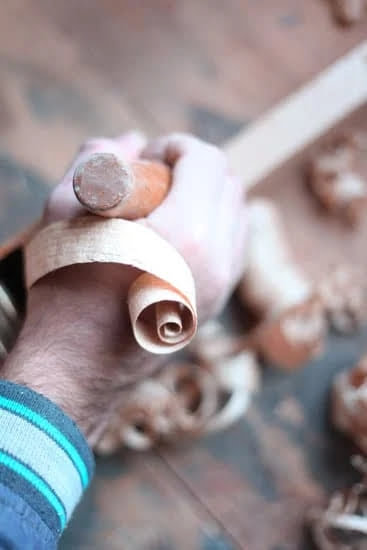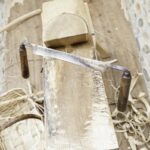Have you ever wondered how woodworkers are able to bend wood on yachts? The art and craft of woodworking on yachts is a complex and fascinating process that requires skill, creativity, and ingenuity.
In this article, we will explore the importance of bent wood in yacht design and the various methods and techniques used by woodworkers to achieve these stunning and functional designs. From steam bending to laminating, we will delve into the tools, equipment, challenges, and case studies that showcase successful wood bending projects on yachts.
Woodworking on yachts is truly an art form that requires a deep understanding of the unique challenges presented by marine environments. Bent wood plays a crucial role in yacht design, from creating elegant curves to providing structural support in confined spaces. The ability to bend wood allows for the creation of intricate and bespoke elements that enhance both the aesthetics and functionality of a yacht.
One of the primary methods used by woodworkers to bend wood on yachts is steam bending. This age-old technique involves using steam to make wood pliable enough to be shaped into desired curves or angles. Another common method is laminating, which involves layering thin strips of wood together with adhesives to achieve complex curves and shapes. These methods require specialized tools and equipment that are tailored to the unique demands of woodworking in a marine environment.
The Importance of Bent Wood in Yacht Design
Bent wood has been a crucial element in yacht design for centuries, providing both structural integrity and aesthetic appeal to these magnificent vessels. The use of bent wood allows for the creation of elegant curves and complex shapes that are not achievable with straight wooden boards. This section will explore the significance of bent wood in yacht construction and how it contributes to the overall design and performance of these impressive watercraft.
A list of points to be discussed:
- Bent wood provides superior strength and flexibility, making it ideal for withstanding the stresses and strains experienced by yachts at sea.
- The use of bent wood allows yacht designers to create innovative and eye-catching designs that set their vessels apart from traditional, straight-lined boats.
- Bent wood also enhances the hydrodynamics of a yacht, supporting smoother movement through water and reducing drag.
The importance of bent wood in yacht design cannot be overstated, as it plays a vital role in both the structural integrity and visual appeal of these seafaring marvels. As we delve deeper into this section, we will examine how talented woodworkers achieve the intricate bends required for creating stunning yacht designs, using methods such as steam bending and laminating.
Methods of Bending Wood
Woodworkers use different methods to bend wood on yachts, and one of the most common techniques is steam bending. This method involves exposing the wood to steam to make it more pliable, allowing it to be bent into the desired shape without breaking. Here are some of the steps involved in steam bending wood on yachts:
- Preparation: The first step in steam bending wood is to select the right type of wood for the project. Woods that are commonly used for steam bending include oak, ash, and mahogany. The wood is then cut into strips or thin planks, depending on the specific design requirements.
- Steam Box: The prepared wood is placed inside a steam box, which is a chamber designed to hold and expose the wood to high levels of steam. The box is heated using a boiler or other source of heat, and the combination of heat and moisture makes the wood more flexible and easier to bend.
- Bending Process: Once the wood has been exposed to steam for a sufficient amount of time, it is quickly removed from the steam box and shaped into its final form. Woodworkers must work swiftly during this phase because once the wood starts to cool down, it will lose its flexibility.
Although steam bending is an effective method for shaping wood on yachts, there are certain limitations and challenges associated with this technique. One issue faced by woodworkers is finding the right balance between applying enough heat and moisture to make the wood pliable without causing damage or weakening its structural integrity.
Additionally, achieving consistent results with steam bending can be challenging due to variations in moisture content, temperature, and other environmental factors. Despite these challenges, experienced craftsmen continue to use steam bending as a preferred method for shaping wooden components on yachts due to its proven effectiveness and versatility.
Methods of Bending Wood
The process of laminating wood is a common method used by woodworkers on yachts to create curved or bent wooden components. This technique involves gluing together thin strips of wood, allowing them to dry and form the desired shape. Laminating is often preferred over steam bending for larger, more complex curves, as it provides greater control and consistency in the final shape.
One common approach to laminating wood on yachts involves using a form or mold that corresponds to the desired curve. Woodworkers carefully glue and clamp the thin strips of wood onto the form, ensuring that they adhere firmly and maintain the intended shape as they dry. Epoxy or waterproof wood glue is typically used in this process to ensure durability and resistance to the elements once installed on the yacht.
In addition to traditional laminating techniques, advancements in technology have also led to the development of modern composite materials for wood bending on yachts. These materials can offer increased strength, flexibility, and resistance to moisture, making them a popular choice for many yacht builders. However, traditionalists continue to value the artistry and craftsmanship involved in using natural hardwoods for laminating and bending wood on yachts.
| Laminating Technique | Advantages |
|---|---|
| Use of forms/molds | Provides control over final shape |
| Traditional hardwoods | Showcases craftsmanship and artistry |
| Modern composite materials | Offers increased strength and resistance to moisture |
Tools and Equipment Needed for Wood Bending on Yachts
Woodworkers who specialize in yacht construction require a variety of tools and equipment for bending wood to meet the curved and complex shapes needed for yacht interiors, exteriors, and furniture. These tools and equipment are essential for achieving the sleek and elegant designs synonymous with luxury yachts.
Steam Bending Equipment
One of the methods used by woodworkers to bend wood on yachts is steam bending. This technique involves exposing wood to steam in order to make it pliable enough to bend into the desired shape. The main equipment needed for steam bending includes a steam box or chamber, a source of steam such as a boiler or heat source, and clamps or molds to hold the wood in place while it bends.
Laminating Tools
Another method commonly used to bend wood on yachts is laminating. This process involves gluing together thin layers of wood, known as veneers, to create a curved shape. The tools required for laminating include clamps or presses to apply pressure while the glue dries, adhesives such as epoxy resin or PVA glue, and forms or molds to give the wood its desired curvature.
Specialized Cutting Tools
In addition to steam bending and laminating equipment, woodworkers on yachts may also need specialized cutting tools such as band saws, jigsaws, or routers to prepare the wood before bending it. These tools allow for precision shaping and cutting of the wood pieces before they are bent into place. Additionally, sanding equipment is essential for smoothing out any rough edges or imperfections after the bending process is complete.
Ultimately, having access to these essential tools and equipment is crucial for woodworkers working on yacht construction projects where achieving precise curves and shapes is paramount.
Challenges and Solutions in Bending Wood on Yachts
Woodworkers face several challenges when it comes to bending wood on yachts. The unique shape and size requirements of yacht components, as well as the need for durability and resistance to water, pose significant hurdles in the wood bending process. However, there are several solutions that woodworkers have developed to overcome these challenges and produce high-quality bent wood components for yachts.
High-Quality Wood Selection
One of the main challenges in bending wood for yachts is ensuring that the wood used is of high quality and suitable for the bending process. Woodworkers must carefully select the right type of wood, such as oak or ash, that has good bending properties and can withstand the demanding conditions of marine environments. Additionally, proper moisture content and grain orientation are crucial factors in achieving successful wood bending on yachts.
Advanced Bending Techniques
To meet the complex design requirements of modern yacht construction, woodworkers have developed advanced bending techniques to create intricate and curved wooden components. This includes using innovative methods such as laminating thin layers of wood together or employing 3D steam bending technology to achieve precise shapes and curves. These advanced techniques allow for greater flexibility in design while maintaining structural integrity and durability.
Protective Finishes
Another challenge in bending wood on yachts is ensuring that the finished product can withstand exposure to moisture, saltwater, and UV radiation without compromising its structural integrity. To address this issue, woodworkers apply high-quality protective finishes to bent wooden components, such as marine-grade varnishes or epoxy coatings. These finishes not only enhance the aesthetic appeal of the wood but also provide long-lasting protection against environmental elements, making them suitable for use on yachts.
As new technologies continue to emerge in woodworking and yacht construction, the challenges associated with bending wood on yachts are continually being addressed with innovative solutions. By combining traditional craftsmanship with modern techniques and materials, woodworkers can meet the demanding requirements of yacht design while creating durable and visually stunning bent wooden components.
Case Studies
Woodworkers on yachts often face the challenge of bending wood to fit the unique curves and shapes of the vessels they work on. The process of bending wood for yacht construction is a crucial aspect of woodworking, as it allows for the creation of custom fittings and designs that enhance the overall aesthetic and functionality of the yacht.
In this section, we will explore some successful wood bending projects on yachts, highlighting the techniques and methodologies used to achieve these impressive results.
One common method of bending wood on yachts is through steam bending. This traditional technique involves exposing thin strips of wood to steam, making them pliable enough to be bent into curved shapes. The steamed wood is then clamped into place until it cools and holds its new shape. This method has been widely used in yacht construction to create curved handrails, frames, and other components that add elegance and functionality to the vessel.
Another popular method used by woodworkers on yachts is laminating. This process involves gluing together thin layers of wood, known as veneers, over a form or mold to create curved shapes. Laminating allows for greater flexibility in design and can produce stronger and more durable curved wood components for yachts. By layering multiple veneers with alternating grains, woodworkers can achieve complex curves that would be difficult or impossible to achieve with solid pieces of wood.
Woodworkers rely on a variety of tools and equipment to successfully bend wood on yachts. Steam chambers, clamps, molds, and specialized glues are just some of the essential items needed for these projects. Additionally, skilled craftsmanship and an understanding of complex curves are crucial for achieving successful wood bending projects on yachts.
| Method | Advantages |
|---|---|
| Steam Bending | Eases flexibility allowing complex curves. |
| Laminating | Results in stronger and more durable components. |
Conclusion
In conclusion, the art and craft of woodworking on yachts is a specialized skill that requires precision, creativity, and an in-depth knowledge of wood bending techniques. The importance of bent wood in yacht design cannot be overstated, as it adds both structural integrity and aesthetic appeal to these luxurious vessels.
As explored in this article, there are two primary methods of bending wood on yachts: steam bending and laminating. Both methods require specific tools and equipment, as well as a thorough understanding of the unique challenges that come with working in a marine environment.
Looking ahead, the future of wood bending in yacht construction will likely continue to evolve as new technologies and materials become available. While traditional methods like steam bending and laminating will remain crucial, there may also be advancements in 3D printing or other innovative techniques that revolutionize the way woodworkers approach their craft on yachts.
Ultimately, the demand for high-quality craftsmanship and custom woodworking on yachts will ensure that wood bending remains a vital aspect of yacht construction for years to come.
Intricate wood bending projects on yachts showcase the impressive skill and dedication of woodworkers who are able to navigate the challenges presented by working in such unique environments. These case studies serve as a testament to the expertise and creativity required to achieve success in bending wood on yachts. As technology continues to advance, it will be fascinating to see how these age-old techniques are adapted and refined to meet the demands of modern yacht design.
Frequently Asked Questions
How Is Wood Bending Done in Industry?
In industry, wood bending is typically done using steam bending or laminating techniques. Steam bending involves heating the wood using steam until it becomes pliable, then quickly bending it into shape and allowing it to cool and set.
Laminating involves layering thin strips of wood together with glue and clamping them into the desired shape until the glue sets. Both methods allow for a wide range of shapes and curves to be achieved in woodworking.
How Did Ancient Shipbuilders Bend Wood?
Ancient shipbuilders used a technique called “rib and plank” construction to bend wood for shipbuilding. This involved shaping the frames of the ship (ribs) by hand and then attaching planks onto them to form the hull.
The natural flexibility of green (freshly cut) wood, combined with soaking the timber in water, made it more pliable and easier to bend into shape for constructing ships.
What Makes Wood Bendable?
Wood is bendable due to its cellular structure, particularly the elongated cellulose fibers that run parallel to the length of a tree trunk. When heat or moisture is applied to wood, these fibers become more flexible and allow the wood to be bent without breaking.
Certain species of wood also have more elastic properties that make them more conducive to bending, such as ash, oak, and mahogany. Additionally, thin sections of wood are generally more bendable than thicker pieces due to their increased flexibility.

Hi everyone! I’m a woodworker and blogger, and this is my woodworking blog. In my blog, I share tips and tricks for woodworkers of all skill levels, as well as project ideas that you can try yourself.





